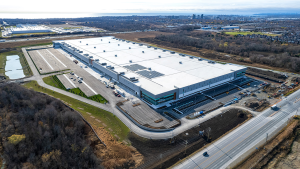Significant progress is being made in the drive to design and build low- and zero- carbon buildings, but there is still long way to go.
That was one of the key points that emerged in an Ontario Association of Architects (OAA)-sponsored panel discussion which aired on its YouTube channel, as part of the association’s 2021 Virtual Conference Week.
Moderated by economist and author Linda Nazareth, the Value of Zero seminar was billed as an event that would showcase the tremendous economic and environmental advantages of high-efficient new and existing buildings.
While a four-member panel of experts from the development, architectural and municipal planning professions did exactly that, they were equally as focused on how barriers to sustainable design can be overcome.
“You (the project stakeholders) have to have an energy budget and use that as a framework for making decisions. You can achieve net zero on budget,” said architect Joanne McCallum, executive officer, co-founder and director of Hamilton-based mcCallumSather.
And having that budget should be ready and available in very early design stages.
Budget projections that compare a building’s projected total energy costs as a baseline factor versus the real cost, once federal government carbon taxes are factored in, should be utilized, she said.
“There are lots of opportunities for incentives,” said McCallum, noting architectural and engineering design teams should source out what government green incentive grants might be available.
Feasibility studies should also be eligible for grants, she suggested.
The architect provided a bit of historical context about co-founding her firm in 1996 with the objective of an integrated team approach to sustainable design.
“I thought the clients would be lining up. I can assure you it didn’t quite work out that way.”
There has certainly been a turnaround since then, said McCallum, citing some of the firm’s projects, such as The Joyce Centre for Partnership and Innovation at Mohawk College in Hamilton.
The 8,918-square-metre facility was that city’s first zero-carbon institutional building.
In 2019, it also became the first Canadian building to receive the Zero Carbon Building Standard certification in both the design and performance categories from the Canada Green Building Council.
The firm was also the mechanical engineering, architectural, heritage and interior design consultant on the Net Zero ready renovation/restoration of the former Canadian Westinghouse headquarters in Hamilton. It was the recipient of the Mechanical Engineering Project of the year at the Hamilton-Halton Engineering Awards in 2020.
The transformation of existing buildings into low carbon ones presents a number of special challenges, said Jamie Gray-Donald, senior vice-president of sustainability and environmental, health and safety with QuadReal Property Group.
“What to do with existing buildings and how do we decarbonize them? There is no study on how to do that,” said Gray-Donald, noting alternative energy sources to natural gas include geoexchange, solar panels and geothermal systems.
In highlighting the progress towards low- and zero-carbon buildings, he pointed out that 50 countries have enacted, or are considering enacting, net-zero legislation. It’s a progression that began with the introduction of the LEED rating system in the late 1990s and has been steadily increasing in momentum with the drive for green building certification during the past 10 years
“The notion of net-zero is not a fringe movement,” said Gray-Donald, explaining there has been a shift by developers in favour of net-zero carbon buildings.
Still, a lot of attitudes, thinking and experiences based on existing buildings get “carried forward. The commercial real estate industry tends to very conservative.
“We (QuadReal) try to be early adopters,” said Gray-Donald, citing the company’s commitment to sustainable design through initiatives such as tracking and recording energy and water consumption and carbon emissions of all its Canadian buildings and then posting the data on its website.
By inputting modelled energy use and carbon intensity into a tool that it has created, the company can also calculate the future energy consumption of new buildings, he said.
“Another generation of (sustainable) technologies is being developed,” said author and venture capitalist Tom Rand, citing, as just one example, the integration of directional lighting in solar panels on the roof of the OAA’s administration building. “Solar panels aren’t just big boxes anymore.”
The developer of Planet Traveler, a low-carbon hotel project in downtown Toronto, Rand also agreed developers are more interested in low carbon buildings compared to just five years ago.
“Today is different. The majority of corporate leaders are interested in climate change,” said Rand, who called on the financial profession to create incentives to entice “sophisticated investors” into the low carbon building market.
An overview of how the City of Toronto is addressing climate change was provided by senior city policy planner Lisa King.
“Buildings account for half of our (the city’s) emissions,” said King, one of the authors of the Toronto Green Standards, a set of performance measures for new development that includes mandatory and voluntary performance tiers, required through planning approvals or incentivized higher performance tiers, she said.
The planner paid tribute to British Columbia’s Energy Step Code which allows local governments to incentivize or require a level of energy efficiency in new construction above what’s required in that province’s building code. In Ontario, though, the situation is different.
“Municipalities don’t have a lot of control to set the bar higher,” said King, in reference to the fact municipalities are subject to the provincial building code energy efficiency requirements for new construction and can’t create bylaws that may conflict with it.











Recent Comments
comments for this post are closed